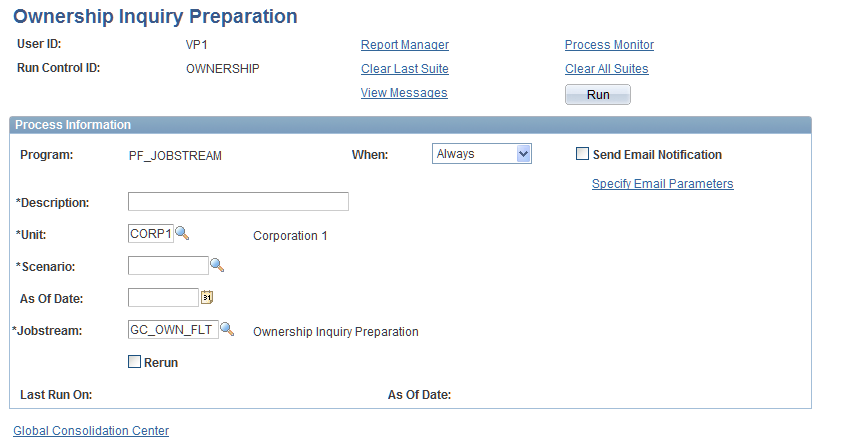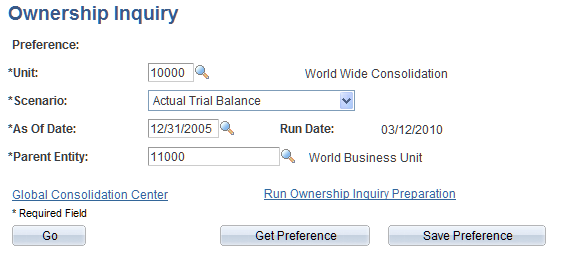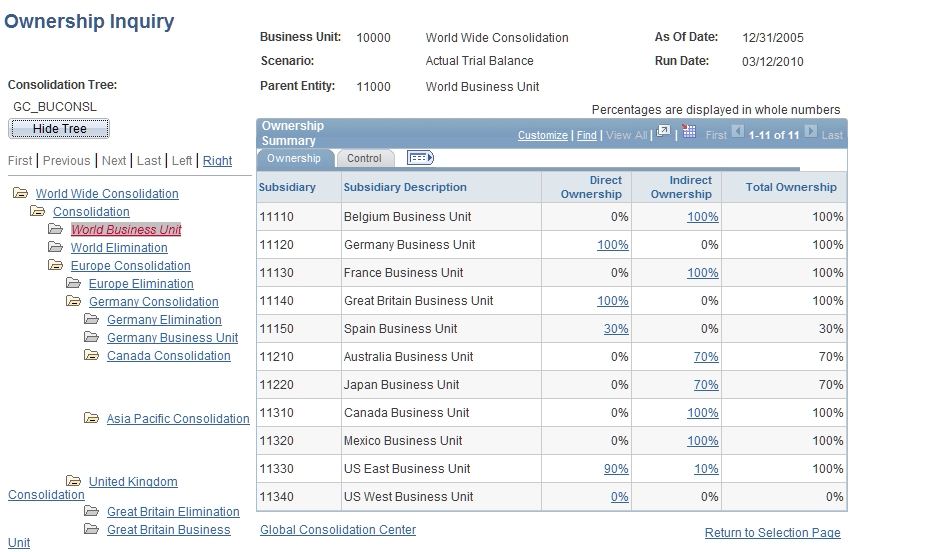Viewing Ownership Hierarchies
This section provides an overview of the ownership inquiry and discusses how to:
Prepare data for ownership inquiries.
Enter ownership inquiry criteria.
Analyze ownership inquiry results.
View indirect ownership percentages.
Pages Used to Analyze Ownership Hierarchy
|
Page Name |
Definition Name |
Navigation |
Usage |
|---|---|---|---|
|
Ownership Inquiry Preparation |
RUN_GC_OWN_FLT |
|
Prepare data for the ownership inquiry. |
|
Ownership Inquiry selection |
GC_OWN_INQ_SEL |
Global Consolidations, Consolidation Analysis, Ownership Analysis, Ownership Inquiry |
Select criteria for the ownership inquiry. |
|
Get Preference |
GC_LEDINQ_PREF_SEL |
Click Get Preference on the Ownership Inquiry selection page. |
Select a preference to use for the Ownership Inquiry selection page. The field values defined for that preference load into the Ownership Inquiry selection page. |
|
Save Preference |
GC_LEDINQ_PREF_SAV |
Click Save Preference on the Ownership Inquiry selection page. |
Save the current settings to a named preference. |
|
Ownership Inquiry summary |
GC_OWN_INQ_SUM |
Click Go on the Ownership Inquiry selection page. |
View the direct and indirect ownership and control of subsidiaries for the selected ledger business unit. |
|
Indirect Ownership |
GC_OWN_INQ_DTL |
Select a percentage link from the Indirect Ownership column or Indirect Control column on the Ownership Inquiry summary page. |
Review details about indirect ownership and indirect control percentage for the selected parent and subsidiary. |
Understanding the Ownership Inquiry
When ownership of subsidiaries has a complex structure, it is useful to examine exactly what subsidiaries a parent owns and controls, both directly and indirectly. The ownership inquiry displays the direct and indirect ownership of a parent and subsidiaries. For example, Parent 1 may directly own Sub A 80% and Sub A owns Sub B directly at 50%. As such, Parent 1 owns Sub B 40% indirectly.
The underlying structure of this inquiry is an ownership inquiry table. In order to populate this table, you use the Ownership Inquiry Preparation run control page to run the Ownership Inquiry Preparation engine. On the Ownership Inquiry Preparation run control page, the user enters the description, business unit, scenario, and as of date. The business unit, scenario, and as of date are used to obtain the ownership group from the model. The engine takes the as of date and uses this date to compare against the current effective date of the ownership rules, ownership rule set, and ownership group. The engine then processes ownership rules and flattens the data into the ownership inquiry table.
For example, if the current effective date of the ownership group, ownership rule set, and ownership rules is 01/01/2000, and the user enters an as of date of 01/01/2005, then the ownership inquiry table is populated based on the rules of 01/01/2000. (The engine takes the current effective row as of the date specified).
The ownership inquiry table is populated with keys such as business unit, scenario, and as of date. The as of date in the table is populated with the as of date from the run control. The run date (the date the engine was run) is also stored on the ownership table for informational purposes, but is not a key.
After the ownership inquiry preparation engine has been run, the user can view the Ownership Inquiry data from the Ownership Inquiry page. On the page, the user enters the consolidation business unit, scenario, as of date, and parent entity to display.
Preparing Data for Ownership Inquiries
Use the Ownership Inquiry Preparation page (RUN_GC_OWN_FLT) to prepare data for the ownership inquiry.
Image: Ownership Inquiry Preparation page
This example illustrates the fields and controls on the Ownership Inquiry Preparation page. You can find definitions for the fields and controls later on this page.

If the ownership structure has changed you should run the ownership inquiry preparation engine prior to accessing the ownership inquiry.
Ownership Inquiry selection Page
Use the Ownership Inquiry selection page (GC_OWN_INQ_SEL) to select criteria for the ownership inquiry.
Image: Ownership Inquiry selection page
This example illustrates the fields and controls on the Ownership Inquiry selection page. You can find definitions for the fields and controls later on this page.

Enter values in these fields:
Ownership Inquiry Summary Page
Use the Ownership Inquiry summary page (GC_OWN_INQ_SUM) to view the direct and indirect ownership and control of subsidiaries for the selected ledger business unit.
Image: Ownership Inquiry summary page
This example illustrates the fields and controls on the Ownership Inquiry summary page. You can find definitions for the fields and controls later on this page.

Using the Ownership Summary - Ownership Grid
The Ownership Summary - Ownership grid displays the subsidiaries who are owned directly or indirectly by the parent and the percentages of direct, indirect, and total ownership.
Using the Ownership Summary - Control Grid
Select the Control tab in the Ownership Summary group box to view the Ownership Summary - Control grid. This grid displays the direct control, indirect control, and total control (sum) of the subsidiaries who are owned directly or indirectly by the parent.
Viewing Direct Ownership Percentages
You can select the link in the direct ownership column to view and update the related ownership rule.
Indirect Ownership Page
Use the Indirect Ownership page (GC_OWN_INQ_DTL) to review details about indirect ownership and indirect control percentage for the selected parent and subsidiary.
Select a percentage link from the Indirect Ownership column or Indirect Control column on the Ownership Inquiry summary page.
Image: Indirect Ownership page
This example illustrates the fields and controls on the Indirect Ownership page. You can find definitions for the fields and controls later on this page.

The top of the page shows the Total Indirect Ownership and Total Indirect Control percentages owned by the parent of the selected subsidiary. Select the Summary hyperlink to return to the Ownership Inquiry - summary page.
The Ownership Details group boxes contains sequence grids that show the details of how the indirect ownership and indirect control are calculated. Within each sequence grid, the following fields are displayed:
In the example above, Mexico is owned through three sequences. The grid details how the indirect percentages are calculated. For example in sequence one, World owns 80% of Germany directly. This is the first row in the grid. In the next row, Germany directly owns 100% of Canada. In the third row, Canada directly owns 70% of Mexico. By multiplying the percentages in this grid (80 X 100 X 70), the system calculates that World owns a 56% indirect ownership of Mexico through the direct parent of Canada.